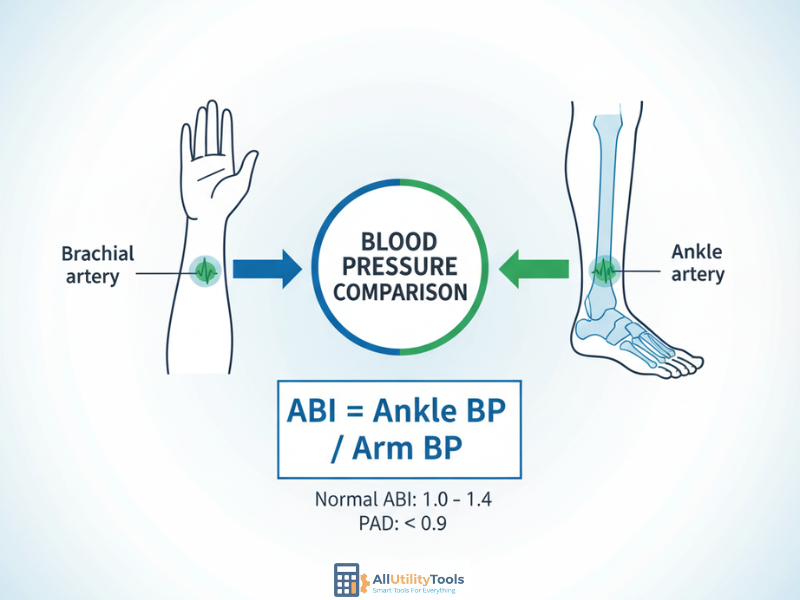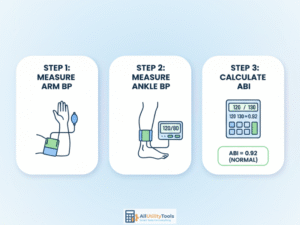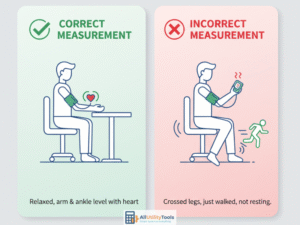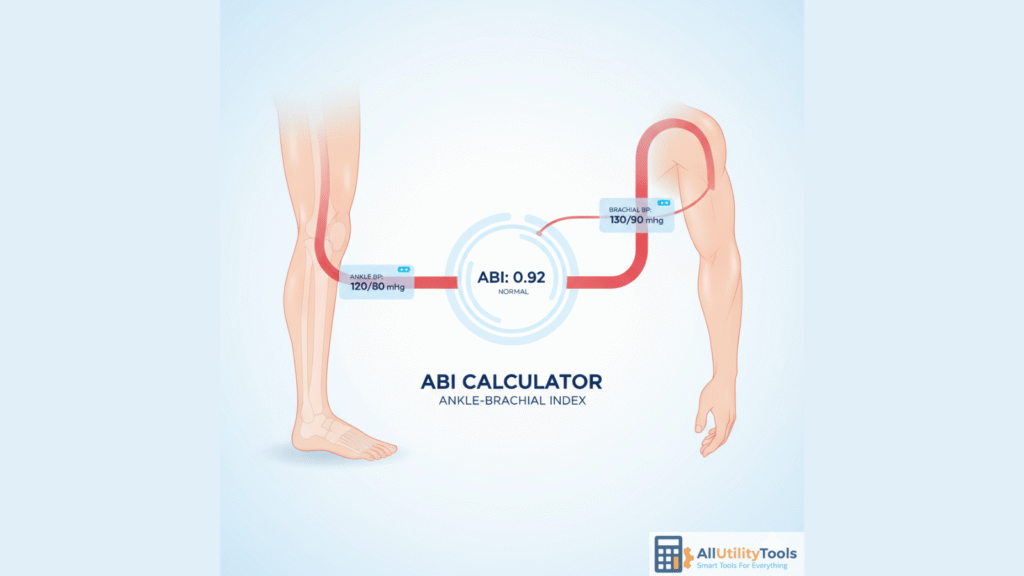What is an ABI Calculator?

The term “ABI” stands for Ankle-Brachial Index. Simply put, it’s a ratio of the systolic blood pressure measured at your ankle compared to the systolic pressure at your arm. NCBI+3Johns Hopkins Medicine+3ummhealth.org+3
Here’s how it works:
- You measure the highest systolic pressure from one of your ankles (typically dorsalis pedis or posterior tibial artery). Medscape+1
- You also measure the highest systolic pressure from one of your arms (brachial artery). Stanford Medicine
- Then you divide the ankle pressure by the arm pressure to get the ABI.
Why do this? Because if the ABI is low, it can mean there’s restricted blood flow in the legs a sign of peripheral arterial disease (PAD) or other circulatory problems.
An “ABI calculator” on our website allows you to input (or approximate) these two pressures and get a quick estimate of your ABI value giving you insight into your vascular health before you visit a clinician.
Why Use It
Why should you use the ABI Calculator? Here are key benefits:
- Early Detection: Many vascular issues (like PAD) develop silently. A lower ABI can signal trouble even before symptoms appear.
- Simplified Understanding: Instead of just seeing blood pressure numbers, you get a ratio that tells a broader story about your circulation arm vs ankle comparison.
- Track Changes Over Time: If you measure periodically (with proper clinical follow-up), you might track improvements or deterioration.
- Support Clinical Conversations: The calculator can prepare you for a doctor’s visit. Knowing your estimated ABI helps you ask more informed questions.
- Accessible and Free: Using the tool on AllUtilityTools.com costs nothing and works in minutes you don’t have to wait for a formal test to begin understanding your state.
Because vascular health is strongly linked to overall cardiovascular risk, using tools like the ABI calculator adds another layer of prevention.
How It Works

Here’s a breakdown of how the ABI calculation process works (and how the calculator handles it):
Step-by-Step Process
- Obtain Arm Systolic Pressure: Measure the blood pressure in both arms, pick the higher systolic reading.
- Obtain Ankle Systolic Pressure: Measure pressures at both ankles (posterior tibial and dorsalis pedis arteries), pick the higher reading per leg.
- Compute the Ratio:
- Interpret the Result:
- ABI between ~1.0 and 1.4 is often considered normal.
- ABI of 0.9 or less suggests you may have PAD.
- ABI above ~1.4 may indicate stiff or non‐compressible arteries (often older age or diabetes).
How Our Calculator Handles It
- You input two values: your ankle systolic pressure (or approximate) and your arm (brachial) systolic pressure.
- The calculator divides one by the other automatically.
- It displays your estimated ABI ratio and gives you a simple interpretation: “normal”, “borderline”, “possible vascular issue see a doctor”.
- Optional: It may allow you to input units (mmHg) and pick left/right values if you have both arms/ankles measured (for more accuracy).
- It displays a small disclaimer reminding that this is an estimate and not a replacement for a medical exam.
The goal: let you quickly see where you stand, and encourage professional follow-up if needed.
How to Use It on AllUtilityTools.com
Using the ABI Calculator on AllUtilityTools.com is simple, intuitive and fast. Here’s the step-by-step guide:
- Navigate to AllUtilityTools.com and select the “Health Tools” or “Vascular / Circulation” section.
- Find the ABI Calculator tool. The landing page will have a short explanation (“Estimate your Ankle-Brachial Index in seconds”).
- Choose your unit system if prompted (mmHg for pressures).
- Enter your Arm Systolic Pressure (in mmHg) in the corresponding field. If you have both arm readings, enter the higher one.
- Enter your Ankle Systolic Pressure in the second field (if you measured both ankles, enter the higher analog reading).
- Click the “Calculate ABI” button.
- Instantly, the calculator shows:
- Your estimated ABI value (e.g., “0.85”)
- A short interpretation (e.g., “Below normal – you may have reduced blood flow in your legs”)
- A note/disclaimer: “This is an estimate. For diagnosis or treatment, consult a healthcare provider.”
- If you’d like, click “Download results” or “Copy link” (if the tool supports it) to keep a record or print it.
- Consider reading our related article or tool, e.g., “Vascular Risk Calculator” or “Leg Circulation Checklist” (links provided).
- If the calculator shows a low or high value (outside normal range), take note — you may want to schedule a formal test with a healthcare provider.
Pro tip: Have your blood pressure readings ready (from recent test or a home monitor), ensure you rested for a few minutes before measuring, and use the tool in a quiet setting.
Real-Life Example

Let’s walk through a realistic scenario to see how the calculator works and how you might interpret it.
Scenario:
- You are 55 years old, you’ve had a blood pressure check and your arm systolic reading is 130 mmHg.
- Later, you measure your ankle (or someone does so) and get 115 mmHg.
- You enter these into the calculator.
- The calculator returns: ABI = 0.88, interpretation: “Slightly below normal. This may indicate reduced blood flow to lower limbs consider professional check-up.”
- What this means: Since 0.88 is lower than 0.9, it suggests possible mild peripheral artery disease. Early lifestyle interventions may help (smoking cessation, exercise, diet), and a doctor may order Doppler ultrasound or other vascular studies.
- Over time, you might retest (every 6-12 months) and if your ankle pressure improves (say to 120 mmHg) while arm remains 130 mmHg, your ABI becomes ~0.92 moving towards a safer range.
Why this is useful:
- You didn’t need a full clinic visit to get a quick estimate.
- You gained insight into circulation health.
- You’re now motivated to act (e.g., improve diet, get a vascular screening) rather than ignore a subtle issue.
- Your doctor visit becomes more productive because you come with a value (“My ABI estimate was 0.88, what do you think?”).
Tips / Mistakes

Here are some practical tips for best use and common mistakes to avoid:
✅ Tips
- Measure when you are rested and calm (blood pressure can vary if you’re stressed or have just walked).
- Use correct cuff size and sit/lie such that your arm and ankle are level with your heart for accuracy.
- If you have both arm or both ankle readings, pick the higher reading for each side (as per clinical convention).
- Use the tool periodically (for example every 6-12 months) to track any changes.
- Combine ABI results with other lifestyle data (smoking history, diabetes, cholesterol, exercise) to build a broader health picture.
❌ Common Mistakes
- Relying on the calculator as a definitive diagnosis (it is an estimate). Always consult a clinician if results appear outside normal.
- Measuring immediately after vigorous activity or when your leg/foot is cold — these factors can skew the readings.
- Ignoring the higher reading convention using a lower reading from an arm or ankle can give misleadingly low ABI.
- Forgetting to include the disclaimer or follow-up plan seeing a “low” result and not acting.
- Assuming a “normal” ABI means everything’s fine other factors (e.g., stiff arteries, diabetes) can give false normal values.
By following good measurement practice and understanding the limitations, you’ll get the most value from our ABI Calculator.
FAQs

Q1: What exactly is a “normal” ABI value?
A: Generally, an ABI between 1.0 and 1.4 is considered normal. ABI of ~0.9 or lower often suggests peripheral artery disease. Values above ~1.4 may reflect stiff or calcified arteries.
Q2: Can I use the ABI Calculator if I don’t have a professional ankle pressure reading?
A: You can use the calculator with any reliable systolic readings you have, but keep in mind that home setups may be less accurate. For exact diagnosis you should get a professional measurement.
Q3: How often should I measure my ABI?
A: If you’re at risk (age 50+, smokers, diabetics, high cholesterol), measuring every 6-12 months can be useful. Use the calculator between professional tests for tracking.
Q4: If my ABI result is low, what should I do next?
A: A low result (e.g., <0.9) suggests reduced circulation. You should consult a health professional who may recommend further testing (ultrasound Doppler), lifestyle changes (exercise, diet), and treat risk factors (smoking, diabetes, hypertension).
Q5: Does a normal ABI guarantee everything is fine?
A: Not always. In certain patients (especially diabetics or older adults), arteries may be stiff and the ABI reading can be artificially high (above ~1.4) and still indicate risk.
Q6: Is the ABI Calculator suitable for children or athletes?
A: The calculator is designed for adults and typical risk profiles. In children, athletes or those with unusual anatomy or conditions, professional measurement and interpretation is strongly recommended.
Conclusion & Call to Action

Your vascular health matters and understanding key markers like the Ankle-Brachial Index gives you a powerful window into circulation, risk, and prevention. Using the free ABI Calculator on AllUtilityTools.com gives you an immediate, user-friendly estimate to begin meaningful conversations about your health.
Take the first step now: Visit AllUtilityTools.com, use the ABI Calculator, enter your systolic arm and ankle pressures, and see your estimated ABI value in seconds. If the result falls outside the typical range (below ~0.9 or above ~1.4) don’t ignore it. Consider a professional check-up, adopt healthy habits (exercise, balanced diet, stop smoking), and monitor regularly.
Your future self will thank you for taking action today. Try our ABI Calculator now and take control of your circulation health.

